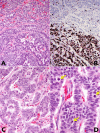Well-Differentiated Neuroendocrine Tumors with a Morphologically Apparent High-Grade Component: A Pathway Distinct from Poorly Differentiated Neuroendocrine Carcinomas
- PMID: 26482044
- PMCID: PMC4988130
- DOI: 10.1158/1078-0432.CCR-15-0548
Well-Differentiated Neuroendocrine Tumors with a Morphologically Apparent High-Grade Component: A Pathway Distinct from Poorly Differentiated Neuroendocrine Carcinomas
Erratum in
-
Correction: Well-Differentiated Neuroendocrine Tumors with a Morphologically Apparent High-Grade Component: A Pathway Distinct from Poorly Differentiated Neuroendocrine Carcinomas.Clin Cancer Res. 2016 Aug 15;22(16):4273. doi: 10.1158/1078-0432.CCR-16-1342. Clin Cancer Res. 2016. PMID: 27528737 No abstract available.
Abstract
Purpose: Most well-differentiated neuroendocrine tumors (WD-NET) of the enteropancreatic system are low-intermediate grade (G1, G2). Elevated proliferation demonstrated by either a brisk mitotic rate (>20/10 high power fields) or high Ki-67 index (>20%) defines a group of aggressive neoplasms designated as high-grade (G3) neuroendocrine carcinoma (NEC). High-grade NEC is equated with poorly differentiated NEC (PD-NEC) and is associated with a dismal outcome. Progression of WD-NETs to a high-grade neuroendocrine neoplasm very rarely occurs and their clinicopathologic and molecular features need to be characterized.
Experimental design: We investigated 31 cases of WD-NETs with evidence of a component of a high-grade neoplasm. The primary sites included pancreas, small bowel, bile duct, and rectum. Histopathology of the cases was retrospectively reviewed and selected IHC and gene mutation analyses performed.
Results: The high-grade component occurred either within the primary tumor (48%) or at metastatic sites (52%). The clinical presentation, radiographic features, biomarkers, and the genotype of these WD-NETs with high-grade component remained akin to those of G1-G2 WD-NETs. The median disease-specific survival (DSS) was 55 months (16-119 months), and 2-year and 5-year DSS was 88% and 49%, respectively-significantly better than that of a comparison group of true PD-NEC (DSS 11 months).
Conclusions: Mixed grades can occur in WD-NETs, which are distinguished from PD-NECs by their unique phenotype, proliferative indices, and the genotype. This phenomenon of mixed grade in WD-NET provides additional evidence to the growing recognition that the current WHO G3 category contains both WD-NETs as well as PD-NECs.
©2015 American Association for Cancer Research.
Figures



References
-
- Niederle MB, Hackl M, Kaserer K, Niederle B. Gastroenteropancreatic neuroendocrine tumours: the current incidence and staging based on the WHO and European Neuroendocrine Tumour Society classification: an analysis based on prospectively collected parameters. ERC. 2010;17:909–18. - PubMed
-
- Kloppel G. Classification and pathology of gastroenteropancreatic neuroendocrine neoplasms. ERC. 2011;18(Suppl 1):S1–16. - PubMed
-
- Hochwald SN, Zee S, Conlon KC, Colleoni R, Louie O, Brennan MF, et al. Prognostic factors in pancreatic endocrine neoplasms: an analysis of 136 cases with a proposal for low-grade and intermediate-grade groups. JCO. 2002;20:2633–42. - PubMed
-
- Ferrone CR, Tang LH, Tomlinson J, Gonen M, Hochwald SN, Brennan MF, et al. Determining prognosis in patients with pancreatic endocrine neoplasms: can the WHO classification system be simplified? JCO. 2007;25:5609–15. - PubMed
Publication types
MeSH terms
Grants and funding
LinkOut - more resources
Full Text Sources
Medical

